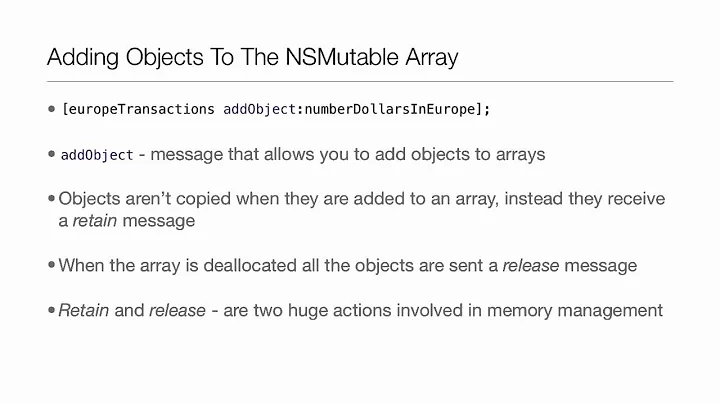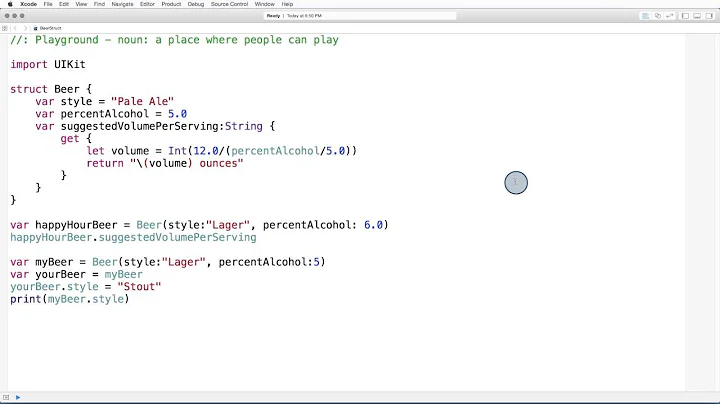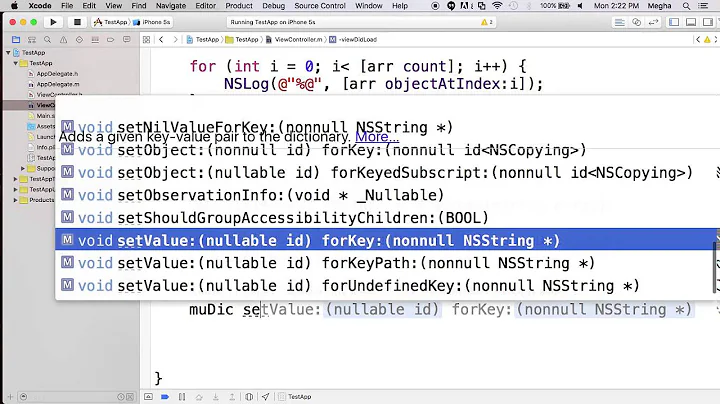Avoiding "NSArray was mutated while being enumerated"
Solution 1
You can always iterate without an enumerator. Which means a regular for loop, and when you remove an object:- decrement the index variable and continue;. if you are caching the array's count before entering the for-loop, then make sure you decrement that too when removing an object.
Anyway, I do not see why an array with objects for later removal would be a problem. I do not know the exact situation which you are having and the technologies involved, but theoretically there should not be a problem. Because in most cases when using this method you can just do nothing in the first enumeration, and do the real work when enumerating the removal array. And if you have a situation where in the first enumeration you are checking something again against the same array and you need to know that the objects are not there anymore, you can just add a check to see if they are in the removal array.
Anyway, hope I helped. Good luck!
Solution 2
You can do something like this:
NSArray *tempArray = [yourArray copy];
for(id obj in tempArray) {
//It's safe to remove objects from yourArray here.
}
[tempArray release];
Solution 3
The simplest way is to enumerate backwards through the array which means the next index won't be affected when you remove an object.
for (NSObject *object in [myMutableArray reverseObjectEnumerator]) {
// it is safe to test and remove the current object
if (AddTestHere) {
[myMutableArray removeObject: object];
}
}
Solution 4
Lock (@synchronized) operation is much faster then copying entire array over and over again. Of course this depends on how many elements the array has, and how often is it executed. Imagine you have 10 threads executing this method simultaneously:
- (void)Callback
{
[m_mutableArray addObject:[NSNumber numberWithInt:3]];
//m_mutableArray is instance of NSMutableArray declared somewhere else
NSArray* tmpArray = [m_mutableArray copy];
NSInteger sum = 0;
for (NSNumber* num in tmpArray)
sum += [num intValue];
//Do whatever with sum
}
It is copying n+1 objects each time. You can use lock here, but what if there is 100k elements to iterate? Array will be locked until iteration is completed, and other threads will have to wait until lock is released. I think copying object here is more effective, but it also depends on how big that object are and what are you doing in iteration. Lock should be always keept for the shortest period of time. So I would use lock for something like this.
- (void)Callback
{
NSInteger sum = 0;
@synchronized(self)
{
if(m_mutableArray.count == 5)
[m_mutableArray removeObjectAtIndex:4];
[m_mutableArray insertObject:[NSNumber numberWithInt:3] atIndex:0];
for (NSNumber* num in tmpArray)
sum += [num intValue];
}
//Do whatever with sum
}
Solution 5
All the above did not work for me, but this did:
while ([myArray count] > 0)
{
[<your delete method call>:[myArray objectAtIndex:0]];
}
Note: this will delete it all. If you need to pick which items need to be deleted, then this will not work.
Related videos on Youtube
glenstorey
We have released BookBot, Silent Light, Math Shake and Times Table Galaxy for iOS and Purrfect Memory of OSX - http://topstoreyapps.com ICT Infrastructure lead for innovative Apple Distinguished School in Papamoa, New Zealand. ADE Class of 2015.
Updated on December 11, 2020Comments
-
glenstorey over 3 years
I have an
NSMutableArraythat stores mousejoints for a Box2d physics simulation. When using more than one finger to play I'll get exceptions statingNSArray was mutated while being enumerated
I know this is because I'm deleting objects from the array while also enumerating through it, invalidating the enum.
What I want to know is what is the best strategy to solve this going forward? I've seen a few solutions online:
@synchronized, copying the array before enumerating or putting the touch joint into a garbage array for later deletion (which I'm not sure would work, because I need to remove the mousejoint from the array straight after removing it from the world). -
Jarrod almost 12 years"Anyway, hope I helped"; Certainly helped me, A LOT! Thank you!
-
Brendt over 11 yearsThis is not true. I still get a mutated while being enumerated exception.
-
 最白目 about 11 yearsthanks for the hint to delete from the original while iterating the copy, it wasnt clear to me.
最白目 about 11 yearsthanks for the hint to delete from the original while iterating the copy, it wasnt clear to me. -
Victor Engel over 10 yearsThis does not work for the same problem but with NSMutableSet rather than arrays. Do you have a suggestion for that scenario?
-
daniel.gindi over 10 years@VictorEngel yes, create a separate set with all the item you wish to remove, then use "minusSet" on the original set (or a mutableCopy of it) with the second set as the argument. :)
-
Tim Arnold about 10 yearsShould
tempArrayinstead be initialized likeNSArray *tempArray = [NSArray arrayWithArray:yourArray]? It seems like this snippet of code wouldn't do what the OP intended -
edc1591 about 10 years@TimArnold I'm pretty sure that would give the same result.
-
 Kaveh Vejdani about 10 yearsTo empty an array you don't need to delete the objects one by one. You can just say myArray = [NSMutableArray init]; Mutating isn't just about deleting, it also includes modifying the objects, which is usually what you want to do. In either case, the right way to "enumerate and mutate" an array is to create a copy of your array first and use that copy to enumerate the objects while you mutate the original array as intended.
Kaveh Vejdani about 10 yearsTo empty an array you don't need to delete the objects one by one. You can just say myArray = [NSMutableArray init]; Mutating isn't just about deleting, it also includes modifying the objects, which is usually what you want to do. In either case, the right way to "enumerate and mutate" an array is to create a copy of your array first and use that copy to enumerate the objects while you mutate the original array as intended. -
Evgen Bodunov over 9 years@Brendt please, show your snippet of code. This answer is seems correct for me. Because we work with different container and it stores all objects from yourArray retained.
-
Nicolas Miari over 9 years
setObject:forKeyis a method of dictionaries, not arrays (also, it must be the mutable version). Otherwise, the method is correct. -
 Allen over 9 yearsI got this error when use block enumerate method in iOS6.
Allen over 9 yearsI got this error when use block enumerate method in iOS6. -
 Itachi over 8 yearsUse
Itachi over 8 yearsUsefor (int = 0; i < yourArray.count; i++) { /* It's safe to remove objects from yourArray here.*/ }, this will not use the enumerator of array. -
 IrelDev about 3 yearssimplest & efficient answer
IrelDev about 3 yearssimplest & efficient answer -
 saagarjha over 2 yearsThis is not correct. From the reverseObjectEnumerator documentation: "When you use this method with mutable subclasses of NSArray, you must not modify the array during enumeration."
saagarjha over 2 yearsThis is not correct. From the reverseObjectEnumerator documentation: "When you use this method with mutable subclasses of NSArray, you must not modify the array during enumeration." -
martinjbaker over 2 yearsThat's a general warning but obviously it is more subtle than that. Modifying the NSMutableArray by inserting or deleting elements EARLIER than the current index will create problems but that isn't what is being done here. Trust me I've been using this technique for 6+ years without a single issue. It works just fine.
-
 saagarjha over 2 yearsJust because it "works fine" does not mean it's correct. You can call private API it too will "work fine" until Apple decides to change it, and then you will crash. You're relying on an internal implementation detail and explicitly doing what the documentation tells you not to do. Use one of the supported ways of doing this, please.
saagarjha over 2 yearsJust because it "works fine" does not mean it's correct. You can call private API it too will "work fine" until Apple decides to change it, and then you will crash. You're relying on an internal implementation detail and explicitly doing what the documentation tells you not to do. Use one of the supported ways of doing this, please. -
martinjbaker over 2 yearsDon't be silly. What "internal implementation detail" am I relying on?







